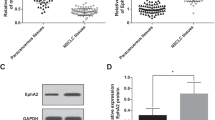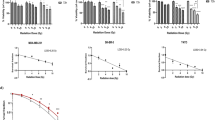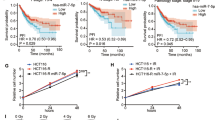Abstract
The purpose of this study was to define the roles of miR-181a in determining sensitivity of cervical cancer to radiation therapy, to explore the underlying mechanism and to evaluate the potential of miR-181a as a biomarker for predicting radio-sensitivity. Tumor specimens from 18 patients with a histological diagnosis of squamous cervical carcinoma (stage IIIB) were used in the micro-RNA profiling and comparison. These patients never received any chemotherapy before radiation therapy. Human cervical cancer cell lines, SiHa and Me180, were used in vitro (cell culture) and in vivo (animal) studies. Transfection of tumor cells with the mimic or inhibitor of miR-181a, and reporter gene assay, were performed to investigate the role of miR-181a in determining radio-sensitivity and the target gene. Higher expression of miR-181a was observed in human cervical cancer specimens and cell lines that were insensitive to radiation therapy, as compared with sensitive cancer specimens and the cell lines. We also found that miR-181a negatively regulated the expression of PRKCD, a pro-apoptotic protein kinase, via targeting its 3′-untranslated region (UTR), thereby inhibiting irradiation-induced apoptosis and decreasing G2/M block. The role of miR-181a in conferring cellular resistance to radiation treatment was validated both in cell culture models and in mouse tumor xenograft models. The effect of miR-181a on radio-resistance was mediated through targeting the 3′-UTR of PRKCD gene. Thus, the expression level of miR-181a in cervical cancer may serve as a biomarker for sensitivity to radiation therapy, and targeting miR-181a may represent a new approach to sensitizing cervical cancer to radiation treatment.
This is a preview of subscription content, access via your institution
Access options
Subscribe to this journal
Receive 50 print issues and online access
$259.00 per year
only $5.18 per issue
Buy this article
- Purchase on Springer Link
- Instant access to full article PDF
Prices may be subject to local taxes which are calculated during checkout






Similar content being viewed by others
References
Jemal A, Bray F, Center MM, Ferlay J, Ward E, Forman D . Global Cancer Statistics. Ca Cancer J Clin 2011; 61: 69–90.
Waggoner SE . Cervical cancer. Lancet 2003; 361: 2217–2225.
Bernstein E, Caudy AA, Hammond SM, Hannon GJ . Role for a bidentate ribbonuclease in the initiation step of RNA interference. Nature 2001; 409: 363–366.
Sevignani C, Calin GA, Siracusa LD, Croce CM . Mammalian microRNAs: a small world for fine-tuning gene expression. Mamm Genome 2006; 17: 189–202.
Zhang B, Wang Q, Pan X . MicroRNAs and their regulatory roles in animals and plants. J Cell Physiol 2007; 210: 279–289.
Lewis BP, Burge CB, Bartel DP . Conserved seed pairing, often flanked by adenosines, indicates that thousands of human genes are microRNA targets. Cell 2005; 120: 15–20.
Takamizawa J, Konishi H, Yanagisawa K, Tomida S, Osada H . Reduced expression of the let-7 MicroRNAs in human lung cancers in association with shortened postoperative survival. Cancer Res 2004; 64: 3753–3756.
Hamano R, Miyata H, Yamasaki M, Kurokawa Y, Hara J, Moon J et al. Overexpression of miR-200c induces chemoresistance in esophageal cancers mediated through activation of the Akt signaling pathway. Clin Cancer Res 2011; 17: 3029–3038.
Hu X, Schwarz JK, Lewis JS, Huettner PC, Rader JS, Deasy JO et al. A microRNA expression signature for cervical cancer prognosis. Cancer Res 2001; 70: 1441–1448.
Begg1 Adrian C., Fiona A, Vens SC . Strategies to improve radiotherapy with targeted drugs. Nat Rev Cancer 2011. 239–253.
Weidhaas JB, Babar I, Nallur SM, Trang P, Roush S, Boehm M et al. MicroRNAs as potential agents to alter resistance to cytotoxic anticancer therapy. Cancer Res 2007; 67: 11111–11116.
Chen G, Zhu W, Shi D, Lv L, Zhang C, Liu P et al. MicroRNA-181a sensitizes human malignant glioma U87MG cells to radiation by targeting Bcl-2. Oncol Rep 2010; 23: 997–1003.
Gschwendt M . Protein kinase C. Eur J Biochem 1999; 259: 555–564.
Watanabe T, Ono Y, Taniyama Y, Hazama K, Igarashi K, Ogita K et al. Cell divisionarrest induced by phorbol ester in CHO cells overexpressing protein kinase C- subspecies. Proc Natl Acad Sci 1992; 89: 10159–10163.
Lu Z, Hornia A, Jiang YW, Zang Q, Ohno S, Foster DA . Tumor promotion by depleting cells of protein kinase C. Mol Cell Biol 1997; 17: 3418–3428.
Blass M, Kronfeld I, Kazimirsky G, Blumberg PM, Brodie C . Tyrosine phosphorylation of protein kinase C δ isessential for its apoptotic effect in response to etoposide. Mol Cell Biol 2002; 22: 182–195.
Basu A, Woolard MD, Johnson CL . Involvement of protein kinase C-δ in DNA damage-induced apoptosis. Cell Death Differ 2001; 8: 899–908.
Denning MF, Wang Y, Tibudan S, Alkan S, Nickoloff BJ . Caspase activation and disruption of mitochondrial membrane potential during UV radiation induced apoptosis of human keratinocytes requires activation of protein kinase C. Cell Death Differ 2002; 9: 40–52.
Yuan ZMUT, Ishiko T, Nakada S, Huang Y, Kharbanda S . Activation of protein kinse C δ by the c-Abl tyrosine kinase in response to ionizing radiation. Oncogene 1998; 16: 1643–1648.
Denning MF, Wang Y, Nickoloff BJ, Wrone-Smith T . Protein kinase C δ is activated by caspase-dependent proteolysis during ultraviolet radiation-induced apoptosis of humankeratinocytes. J Biol. Chem 1998; 273: 29995–30002.
Basu A, Akkaraju GR . Regulation of caspase activation and cis-diamminedichloroplatinum(II)- induced cell death by protein kinase C. Biochemistry 1999; 38: 4245–4251.
Acknowledgements
We are most grateful for the pWPXL, psPAX2 and pMD2.Glentivirus plasmids that were provided by Professor Didier Trono from the School of Life Sciences, EcolePoly technique Fédérale de Lausanne, 1015 Lausanne, Switzerland. This work was supported by National Natural Science Foundation of China (No. 81072128), and Science and Technology Commission of Shanghai Municipality (Academic leader foundation of Shanghai, 09XD1401100).
Author information
Authors and Affiliations
Corresponding authors
Ethics declarations
Competing interests
The authors declare no conflict of interest.
Additional information
Supplementary Information accompanies the paper on the Oncogene website
Supplementary information
Rights and permissions
About this article
Cite this article
Ke, G., Liang, L., Yang, J. et al. MiR-181a confers resistance of cervical cancer to radiation therapy through targeting the pro-apoptotic PRKCD gene. Oncogene 32, 3019–3027 (2013). https://doi.org/10.1038/onc.2012.323
Received:
Revised:
Accepted:
Published:
Issue Date:
DOI: https://doi.org/10.1038/onc.2012.323
Keywords
This article is cited by
-
A novel natural killer-related signature to effectively predict prognosis in hepatocellular carcinoma
BMC Medical Genomics (2023)
-
Overview of genetic and epigenetic regulation of human papillomavirus and apoptosis in cervical cancer
Apoptosis (2023)
-
DSCAM-AS1 promotes cervical carcinoma cell proliferation and invasion via sponging miR-338-3p
Environmental Science and Pollution Research (2022)
-
Inhibition of Delta-like Ligand 4 enhances the radiosensitivity and inhibits migration in cervical cancer via the reversion of epithelial–mesenchymal transition
Cancer Cell International (2020)
-
Role of microRNAs in epidermal growth factor receptor signaling pathway in cervical cancer
Molecular Biology Reports (2020)



